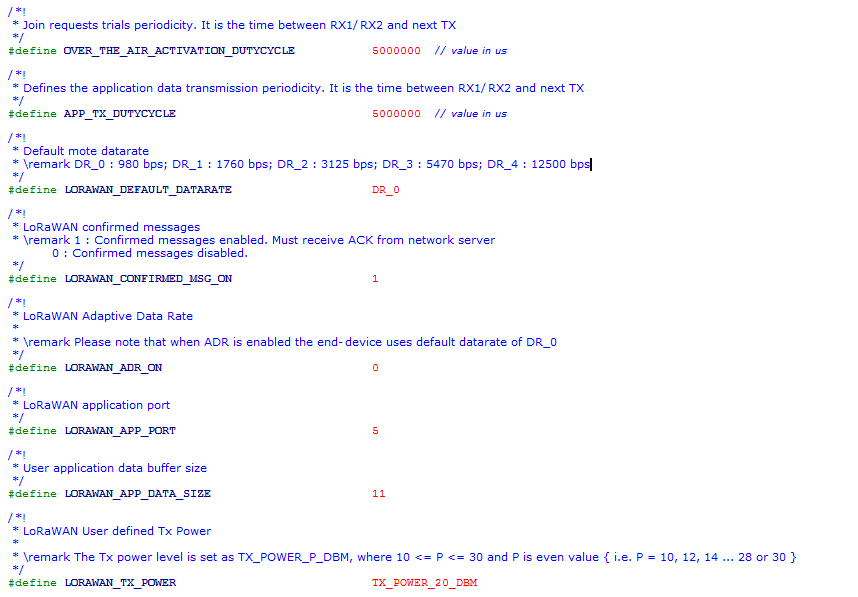SX1276 Shield based Applications
Dependencies: X_NUCLEO_IKS01A1 LoRaWAN-lib SX1276Lib mbed
LoRaWAN-SX1276-Application Demo uses SX1276MB1LAS mbed component shield on a nucleo board platform to demonstrate a Class-A LoRaWAN device in the 915MHz ISM band for North American region. It uses the LoRaWAN-lib and SX1276Lib libraries.
Comissioning.h (LoRaWAN Network Configuration)
The end-device can be activated in one of the two ways:
Over the Air (OTA) activation can be enabled as shown in the figure below.

The end-device must be configured with the following parameters:
LORAWAN_DEVICE_EUI(8 Bytes) : Fist 3 Bytes is the Organizationally Unique Identifier (OUI) followed by 5 bytes of unique ID. If not defined by user, then the firmware automatically assigns one to the end-deviceLORAWAN_APPLICATION_EUI(8 Bytes)LORAWAN_APPLICATION_KEY(or DEVKEY) (16 Bytes)

Activation by Personalization (ABP) can be enabled as shown in the figure below.

The end-device must be configured with the following parameters:
LORAWAN_DEVICE_ADDRESS(4 Bytes) : If not defined by user, then the firmware automatically assigns one to the end-deviceLORAWAN_NWKSKEY(16 Bytes)LORAWAN_APPSKEY(16 Bytes)

Config.h (LoRaWAN Communication Parameters)
- Mode of Operation : Hybrid
If the end-device needs to be configured to operate over 8-channels, then
Hybrid Modeneeds to be enabled
- Mode of Operation : Frequency Hop
If the end-device needs to be configured to operate over 64-channels, then
Hybrid Modeneeds to be disabled
- Delay between successive JOIN REQUESTs :
The delay between successive Join Requests (until the end-device joins the network) can be configured using the parameter
OVER_THE_AIR_ACTIVATION_DUTYCYCLE
- Inter-Frame Delay :
One can change the delay between each frame transmission using
APP_TX_DUTYCYCLEIt is advisable thatAPP_TX_DUTYCYCLEis greater than or equal to 3sec.
- Data Rate :
The data rate can be configured as per LoRaWAN specification using the paramter
LORAWAN_DEFAULT_DATARATE. The range of values are DR_0, DR_1, DR_2, DR_3 and DR_4
- Confirmed/Unconfirmed Messages :
The uplink message or payload can be chosen to be confirmed or unconfirmed using the parameter
LORAWAN_CONFIRMED_MSG_ON. When set to 1, the transmitted messages need to be confirmed with anACKby the network server in the subsequent RX window. When set to 0, noACKis requested.
- ADR ON/OFF :
The ADR can be enabled or disabled using the parameter
LORAWAN_ADR_ON. When set to 1, ADR is enabled and disabled when set to 0.
- Application Port :
The application port can be set using parameter
LORAWAN_APP_PORT. A few examples are associated to specific Application Port, and are defined in Config.h
- Payload Length :
The lenght of the payload (in bytes) to be transmitted can be configured using
LORAWAN_APP_DATA_SIZE
- Transmit Power :
The transmit power can be configured using
LORAWAN_TX_POWER(LoRaMAC verifies if the set power is compliant with the LoRaWAN spec and FCC guidelines)

The baud-rate for serial terminal display is 115200
app/LoRaMacLayerService.cpp
- Committer:
- ubhat
- Date:
- 2018-07-18
- Revision:
- 6:c5f2da0de0b0
- Parent:
- 0:42863a11464a
File content as of revision 6:c5f2da0de0b0:
/*
/ _____) _ | |
( (____ _____ ____ _| |_ _____ ____| |__
\____ \| ___ | (_ _) ___ |/ ___) _ \
_____) ) ____| | | || |_| ____( (___| | | |
(______/|_____)_|_|_| \__)_____)\____)_| |_|
(C)2015 Semtech
Description: MAC Layer Services: MLME & MCPS
License: Revised BSD License, see LICENSE.TXT file include in the project
Maintainer: Uttam Bhat
*/
#include "LoRaMacLayerService.h"
/*!
* \brief MCPS-Confirm event function
*
* \param [IN] McpsConfirm - Pointer to the confirm structure,
* containing confirm attributes.
*/
void McpsConfirm( McpsConfirm_t *McpsConfirm )
{
if( McpsConfirm->Status == LORAMAC_EVENT_INFO_STATUS_OK )
{
switch( McpsConfirm->McpsRequest )
{
case MCPS_UNCONFIRMED:
{
// Check Datarate
// Check TxPower
break;
}
case MCPS_CONFIRMED:
{
// Check Datarate
// Check TxPower
// Check AckReceived
// Check NbRetries
LoRaMacUplinkStatus.Acked = McpsConfirm->AckReceived;
break;
}
case MCPS_PROPRIETARY:
{
break;
}
default:
break;
}
}
LoRaMacUplinkStatus.Datarate = McpsConfirm->Datarate;
LoRaMacUplinkStatus.UplinkCounter = McpsConfirm->UpLinkCounter;
LoRaMacUplinkStatus.TxPower = McpsConfirm->TxPower;
IsTxIntUpdate = true;
}
/*!
* \brief MCPS-Indication event function
*
* \param [IN] McpsIndication - Pointer to the indication structure,
* containing indication attributes.
*/
void McpsIndication( McpsIndication_t *McpsIndication )
{
uint8_t port;
if( McpsIndication->Status != LORAMAC_EVENT_INFO_STATUS_OK )
{
return;
}
switch( McpsIndication->McpsIndication )
{
case MCPS_UNCONFIRMED:
{
break;
}
case MCPS_CONFIRMED:
{
break;
}
case MCPS_PROPRIETARY:
{
break;
}
case MCPS_MULTICAST:
{
break;
}
default:
break;
}
// Check Multicast
// Check Port
// Check Datarate
// Check FramePending
// Check Buffer
// Check BufferSize
// Check Rssi
// Check Snr
// Check RxSlot
LoRaMacDownlinkStatus.Rssi = McpsIndication->Rssi;
if( McpsIndication->Snr & 0x80 ) // The SNR sign bit is 1
{
// Invert and divide by 4
LoRaMacDownlinkStatus.Snr = ( ( ~McpsIndication->Snr + 1 ) & 0xFF ) >> 2;
LoRaMacDownlinkStatus.Snr = -LoRaMacDownlinkStatus.Snr;
}
else
{
// Divide by 4
LoRaMacDownlinkStatus.Snr = ( McpsIndication->Snr & 0xFF ) >> 2;
}
LoRaMacDownlinkStatus.DownlinkCounter++;
LoRaMacDownlinkStatus.RxData = McpsIndication->RxData;
LoRaMacDownlinkStatus.Port = McpsIndication->Port;
LoRaMacDownlinkStatus.Buffer = McpsIndication->Buffer;
LoRaMacDownlinkStatus.BufferSize = McpsIndication->BufferSize;
LoRaMacDownlinkStatus.RxSlot = McpsIndication->RxSlot;
if( ComplianceTest.Running == 1 )
{
port = 224;
ComplianceTest.DownLinkCounter++;
}
else
{
port = McpsIndication->Port;
}
if( McpsIndication->RxData == true )
{
switch( port )
{
case 1: // The application LED can be controlled on port 1 or 2
case 2:
break;
case 224:
PrepareComplianceTestFrame( McpsIndication );
break;
default:
break;
}
}
IsRxUpdate = true;
}
/*!
* \brief MLME-Confirm event function
*
* \param [IN] MlmeConfirm - Pointer to the confirm structure,
* containing confirm attributes.
*/
void MlmeConfirm( MlmeConfirm_t *MlmeConfirm )
{
if( MlmeConfirm->Status == LORAMAC_EVENT_INFO_STATUS_OK )
{
switch( MlmeConfirm->MlmeRequest )
{
case MLME_JOIN:
{
// Status is OK, node has joined the network
IsNetworkJoinedStatusUpdate = true;
break;
}
case MLME_LINK_CHECK:
{
// Check DemodMargin
// Check NbGateways
if( ComplianceTest.Running == true )
{
ComplianceTest.LinkCheck = true;
ComplianceTest.DemodMargin = MlmeConfirm->DemodMargin;
ComplianceTest.NbGateways = MlmeConfirm->NbGateways;
}
break;
}
default:
break;
}
}
// Schedule next packet transmission
TimerSetValue( &TxNextPacketTimer, OVER_THE_AIR_ACTIVATION_DUTYCYCLE );
TimerStart( &TxNextPacketTimer );
DeviceState = DEVICE_STATE_SLEEP;
}